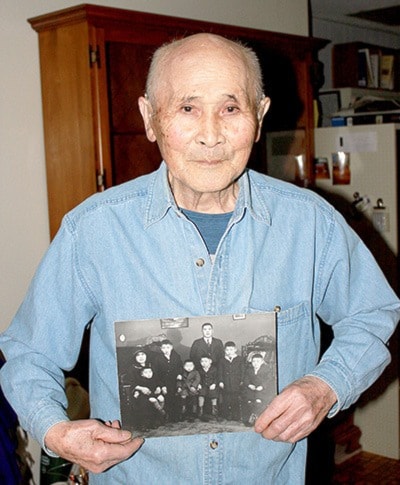From his home near 100 Mile House, Joe Komori smiles, his good humour shining with a positive attitude well-known to many who know him in the community.
This day, he shares his pleasure in learning the internment camp where he spent years of his childhood is being recognized for historic significance to British Columbians.
The Taylor Lake camp is one of 56 Japanese-Canadian sites chosen to be listed with statements of significance on the B.C. Register of Historic Places, of 176 places nominated.
Included in the recognized sites are internment camps, self-supporting sites, and road camps where Japanese-Canadians, such as the Komori family, were held or forced to work during the Second World War internment years.
Joe spent much of his childhood at the Taylor Lake Japanese Internment Site southwest of Lone Butte – about 20 kilometres east of where he lives now – and he is pleased to see it recognized for future generations to learn from and understand what happened, he explains.
"Everything was 'hush-hush', you know? And [most] Japanese people, they don't want to speak out, we keep more held inside. And now that the seniors are gone, their stories are gone, so the third and fourth generations are starting to open up, who had heard these stories," he says.
Joe says his parents and the other adults who lost their homes and livelihoods to bring their families to what was essentially a confined prison site suffered much more back then than their younger children, like him, who naturally lived more of their daily routines than noticing the family birthrights, bequests or even freedoms they'd lost.
Taking things in stride is the way of Japanese families, the way he was raised, so Joe saw very little of his parents' struggle shown in their faces or in their comments, he explains.
He joined a league of three baseball teams that got going, and enjoyed more of the opportunities for playing other games in the outdoors, like many of his young friends, he explains.
Joe says he and his eight brothers and sisters had moved with their parents from a small property in Vancouver on the Fraser River delta where they "just went two miles here and there and that was it" to a whole new outdoor camp experience where he played in the woods, ran in the fields and skated on the lake.
"It opened up a different view, to see different places and make different friends. So I think it was not all bad, for the younger generations."
While he can only estimate that about 160 Japanese people were incarcerated there, he figures there were perhaps 30-40 families interned at the Taylor Lake camp, and each averaged four or five children.
"We take what comes, when we can't fight back. So, the Japanese did what they were told to do, there was no choice – you go, or you go to a concentration camp."
Once grown, he realized much more of what his parents had suffered.
When the war hit Canada in 1942, Joe's father, Matsunosuke Komori, mother, Haru Komori, and all of their 10  children lived in a large home, and the older family members worked on their family's fleet of five fishing boats.
children lived in a large home, and the older family members worked on their family's fleet of five fishing boats.
All of these assets were taken from his family by the government of the time and were never returned.
"My parents, they worked so hard for 30-40 years, and all of a sudden it was gone. It was all confiscated.
"Right across B.C., all the [Japanese] families lost their property, everything – their business, everything."
While some financial compensation was made in later years, this wasn't until the 1980s, and applied only to those who were interned themselves – and only if they were still alive almost 30 years later, Joe explains.
Last August, a commemorative plaque about the Taylor Lake Japanese Internment Camp and the experiences of the Komori family, as told by Joe, was erected at the 100 Mile Community Hall plaza.
Joe says he hopes this provincial heritage recognition will open up more stories about what happened to those who haven't learned about this atrocity, including how the government of the time "just accepted these things."
"Government should, hopefully, have more stories to be told. In 100 Mile House, people know what happened now, because of that plaque. Any other place, they know hardly anything ... and they have to know.
"It may not soon happen ... but people forget, time and again, so it could happen all over again."
The hardworking Komori family persevered, and after the war stayed in the area to become prominent businessmen, operating a large sawmill operation at Tin Cup Lake east of 70 Mile House. Komori Lumber employed many South Cariboo people in family-supporting jobs – without the discrimination this Japanese-Canadian family had suffered themselves.
History shows more than 22,000 Japanese-Canadian people were uprooted from their livelihoods, businesses, homes, culture and language base, and imprisoned away from what was deemed a "protected area" within 100 miles of the B.C. coast and islands.
Many communities with large Japanese-Canadian populations prior to 1942 never saw the return of their former residents after 1949.
All 176 publicly-nominated places appear on an interactive map produced by Heritage BC, online at https://secure.heritagebc.ca/japanese-canadian-map/?lang=en.
